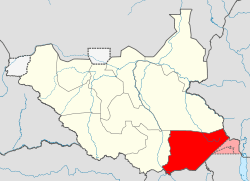Didinga Hills
| Didinga Hills | |
|---|---|
 Location in South Sudan | |
| Elevation | 1,961 metres (6,434 ft) |
| Geography | |
| Country | South Sudan |
| State | Namorunyang State |
| Range coordinates | 4°20′00″N 33°35′00″E / 4.3333°N 33.5833°ECoordinates: 4°20′00″N 33°35′00″E / 4.3333°N 33.5833°E |
The Didinga Hills are an upland area in Namorunyang State of South Sudan, lying mainly within Budi County. Before the reorganisation of states, it was a oart of Eastern Equatoria.[1] They are named for the Didinga people who live in the region. The Didinga Hills have rich and fertile soil that is used for cultivation of tobacco, potatoes, maize, and Dura.[2]
The Nakodok, Narus and Loyoro rivers originate in the east of Didinga Hills, flowing eastward into Greater Kapoeta and discharging into the swampy area northeast of Narua. The rivers flood during the rainy season, but ceases to flow at other times.[3] In the dry season the Toposa from Greater Kapoeta would drive their cattle to the Didinga Hills for water and pasture until the rains began in Toposa land. In the past, this practice was carried out by agreement between the two communities, with a gift being made in exchange for the right to access the pasturage. With the proliferation of guns and breakdown of order during the civil war, the traditional protocols were ignored and violence became common.[4]
The village of Chukudum lies at the base of the Didinga Mountains, which are often shrouded in clouds, in spectacularly beautiful country. It is accessible only by a rough track.[5]
References
- ↑ "TOPOSAS' RAID IN NGAURO COUNTY LEAVES AT LEAST 15 PEOPLE DEAD". Nyamile. Retrieved 2016-09-06.
- ↑ "Focus On South: Facts About Eastern Equatoria State". Sudan Vision Daily. Retrieved 2011-07-07.
- ↑ "Geologic Survey of Kapoeta County" (PDF). University of Missouri. Retrieved 2011-07-22.
- ↑ "CROSS-BORDER PEACE & SPORTS PROGRAMME FOR YOUTH WARRIORS SUDAN/UGANDA/KENYA" (PDF). Seeds of Peace Africa. 2009–2011. Retrieved 2011-07-16.
- ↑ "Funeral of Fr. Lino Novato Sebit in Chukudum". cfr Sudan Mission. October 2, 2008. Retrieved 2011-07-14.
